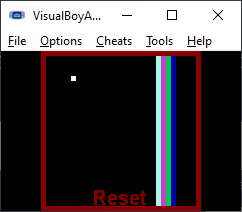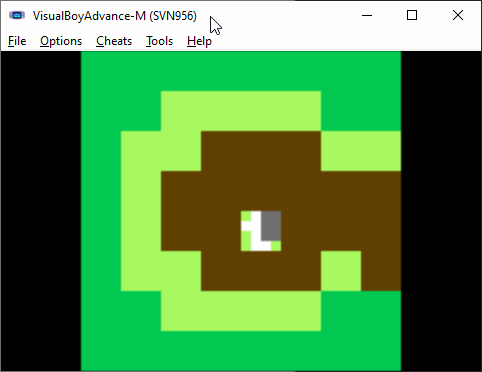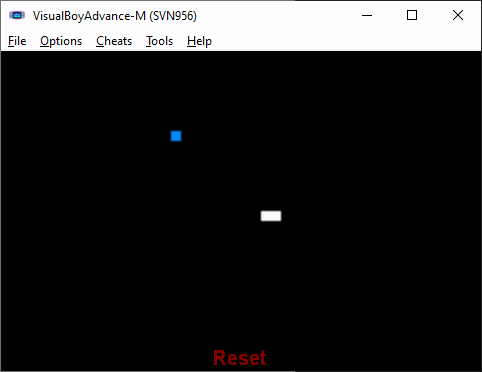Fantasy console on a console
Introduction
Back in April 2019 I decided to get into emulation and thought about writing a simple one. I read about the MOS 6502 microprocessor and it looked promising as it was used in famous products such as Apple II, Commodore 64, BBC Micro, Tamagotchi and others.
One would typically program this in the 6502 assembly, for more information check out the wonderful Easy6502 interactive ebook by Nick Morgan, it includes an emulator as well.
The MOS 6502 is interesting to program from the 2019 viewpoint, as it has only 3 registers and 64 KB of memory divided into pages. The first 256 bytes of the memory are special, it’s called the ‘zero-page’ and can be accessed faster than the rest.
Sample 6502 code:
LDA #$10
STA $a0
LDY #$03
STA $0200,X
INX
DEY
BNE $0606
DEC $a0
LDA $a0
BNE $0604
Emulation
I eventually ended up with a working 6502 emulator, hosted here on Github as emu6502. Emu6502 is written in C, has a hand-written test-suite in 6502 machine code, was developed mostly in Visual Studio 2019, but compiles with gcc and emscripten as well.
The emulator itself is simple - it operates over a state structure with the values of CPU registers, memory and flags. There is an instruction decoder implemented as a giant switch statement and implementation of each instruction handler.
Getting some output
The CPU on its own isn’t that useful, as we need some way to handle input and output. Simple hardware usually has memory-mapped I/O, so the controller buttons could appear at some memory location, and when one writes to another memory location, the video chip would pick this up and display it. I looked around for similar projects and found 6502asm, self-titled “World’s first fantasy console!”.
The specification of the fantasy console is quite simple - 32x32 pixels of 16 colors each, input handled by sending ASCII code to address $FF and random generator output at $FE. Memory locations $200 to $5FF map to the screen pixels. No sound, sprites or other console niceties. The advantage of going for an existing ‘platform’ is that I had plenty of available projects ready as people developed some cool things against 6502asm, so I would not have to develop my own games on top of the emulator.
The initial run of emu6502 was done in a Windows console window, which is not so nice to look at and I thought about porting this to an actual console with a screen and buttons.
I like Nintendo hardware, so I ended up with two ports - both Nintendo consoles - Game Boy Advance and the 3DS.
Game Boy Advance port
Code lives here: gba-6502.
For homebrew development I used the excellent devkitPro toolchain.
Graphics
The Game Boy Advance has a couple of graphic modes, we’re using Mode 3, which is a bitmap mode, with a resolution of 240x160. The colors are stored in a palette, see color.c
The second GBA-specific module is in aptly named main.c. This module handles rendering - which is extremely simple:
void draw_memory()
{
for (int y = 0; y < 32; y++)
{
for (int x = 0; x < 32; x++)
{
//160x160 - 5x5 px box per pixel
draw_square(x*PIXEL_SIZE+SCREEN_OFFSET_LEFT, y*PIXEL_SIZE, PIXEL_SIZE, get_color(state.memory[0x200 + x + y * DISP_WIDTH]));
}
}
}
What does this mysterious draw_square do? Unfortunately there is no 2D drawing library, so it just draws individual pixels…
inline void draw_square(int x, int y, int size, int color)
{
for (int yy = 0; yy < size; yy++)
for (int xx = 0; xx < size; xx++)
vid_mem[(y + yy) * SCREEN_WIDTH + x + xx] = color;
}
…into the video memory
#define MEM_VRAM 0x06000000
#define vid_mem ((u16 *)MEM_VRAM)
inline void draw_point(int x, int y, int clr)
{
vid_mem[y * SCREEN_WIDTH + x] = clr;
};
palette[0] = 0x0;
palette[1] = 0x7fff;
palette[2] = 0x11;
palette[3] = 0x77f5;
To obtain this palette, Python script helped convert 32-bit hexcodes into 16-bit:
palette = ["#000000", "#ffffff", "#880000", "#aaffee",
"#cc44cc", "#00cc55", "#0000aa", "#eeee77",
"#dd8855", "#664400", "#ff7777", "#333333",
"#777777", "#aaff66", "#0088ff", "#bbbbbb"]
i = 0
for r,g,b in [(int(color[1:3],16), int(color[3:5],16), int (color[5:7],16)) for color in palette]:
gba_color = (((r >> 3) & 31) | (((g >> 3) & 31) << 5) | (((b >> 3) & 31) << 10))
print(f'palette[{i}] = {hex(gba_color)};')
i = i+1
Loading a game binary
Unfortunately the GBA doesn’t have a flash memory to store the individual game ROMs, so I had to use the following workflow to add a game binary:
how to run your own binaries
- Compile binaries with 6502js - develop, assemble, click
binary. - Convert binary into a C hex array with
gen/gen_bin_c.py - Paste hex array into
load_bin_from_memoryinemu_gba.c - Adjust the size of the binary in
load_bin_from_memory(see the memcpy call)
Basically we’d end up with something like this for a simple program.
void load_bin_from_memory(){
char bin[] = {0xa9,0x2,0x85,0x1,0xa9,0x3,0x85,0x3,0xa9,0x4,0x85,0x5,0xa9,0x5,0x85,0x7,0xa9,0x33,0x85,0x10,0xa9,0xaa,0x85,0x11,0xa4,0xfe,0xa5,0xfe,0x91,0x0,0x4a,0x4a,0x4a,0x4a,0x4a,0x4a,0x4a,0x91,0x2,0x5,0x11,0x91,0x4,0xa6,0xfe,0x86,0x20,0x5,0x20,0x91,0x6,0x4c,0x18,0x6};
memcpy(state.memory + PRG_START, bin, 54);
}
Once we have the binary loaded in the program state (a buffer of 65336 bytes), the program counter pointed at the PRG_START (0x600), the emulation can progress as usual - code flowing, checking for user input and flipping bits in the video memory, which we need to somehow render.
There are two modules that are specific to Game Boy Advance - the emulator loop, ROM loading from memory (see above) and input handling in emu_gba.c,
void emu_tick(){
state.memory[0xFF] = last_key & 0xFF;
state.memory[0xfe] = rand() & 0xFF;
if(state.flags.b != 1)
emulate_6502_op(&state);
}
Key handling
It seems I have forgotten to actually implement reading of the keys to send to the emulator. The 6502js games typically expect the wsad keys, so it would be nice to convert the native GBA keycodes into those. As a refresher, I wrote a quick program to display the keycode as a “bar length”.
define currentKey $ff
define lastKey $2
loop:
;load last pressed key into X, compare with last key
ldx currentKey
cpx lastKey
;if the key is the same as the last time, loop again
beq loop
;store the new lastKey
stx lastKey
;clear screen on new key
lda #0
ldy #255
clear:
sta $0200,y
dey
bne clear
;change color based on the key code
lda lastKey
;draw a bar the length of the key code
key_loop:
;loop from key code down to 0
STA $0200,X
dex
;while x > 0
bpl key_loop
jmp loop
To actually read the keys one should call scanKeys(); to obtain the keypad state and then call the keysDown() function to get the keys that have been pressed, as documented in devkitPro gba_input.h.
We can do this in the VblankInterrupt function, which is an interrupt raised on every frame, assigning the value from keysDown() into the global last_key variable, which we stuff into the 0xff zero-page memory location on every emulator tick.
void VblankInterrupt()
//---------------------------------------------------------------------------------
{
frame += 1;
scanKeys();
last_key = keysDown();
}
int main(void)
{
...
// Set up the interrupt handlers
irqInit();
irqSet(IRQ_VBLANK, VblankInterrupt);
// Enable Vblank Interrupt to allow VblankIntrWait
irqEnable(IRQ_VBLANK);
// Allow Interrupts
REG_IME = 1;
...
With this code we obtain some key code, but not in the format that the emu6502 games expect (WASD ASCII key codes).
The keys are actually defines as:
typedef enum KEYPAD_BITS {
KEY_A = (1<<0), /*!< keypad A button */
KEY_B = (1<<1), /*!< keypad B button */
KEY_SELECT = (1<<2), /*!< keypad SELECT button */
KEY_START = (1<<3), /*!< keypad START button */
KEY_RIGHT = (1<<4), /*!< dpad RIGHT */
KEY_LEFT = (1<<5), /*!< dpad LEFT */
KEY_UP = (1<<6), /*!< dpad UP */
KEY_DOWN = (1<<7), /*!< dpad DOWN */
KEY_R = (1<<8), /*!< Right shoulder button */
KEY_L = (1<<9), /*!< Left shoulder button */
KEYIRQ_ENABLE = (1<<14), /*!< Enable keypad interrupt */
KEYIRQ_OR = (0<<15), /*!< interrupt logical OR mode */
KEYIRQ_AND = (1<<15), /*!< interrupt logical AND mode */
DPAD = (KEY_UP | KEY_DOWN | KEY_LEFT | KEY_RIGHT) /*!< mask all dpad buttons */
} KEYPAD_BITS;
So let’s cheat and look at the individual bits.
The fixed input routine:
void handleKeys(){
scanKeys();
u16 kDown = keysDown();
if (kDown & KEY_LEFT)
last_key = 'a';
else if (kDown & KEY_DOWN)
last_key = 's';
else if (kDown & KEY_RIGHT)
last_key = 'd';
else if (kDown & KEY_UP)
last_key = 'w';
}
To test the entire tool I chose the lazy option and used a GBA emulator. I suppose it should run on a device as well, but right now I don’t own any GBA flash carts ☹️.
Performance
To make this run reasonably fast, the emulator executes 256 ticks between frames (found empirically.) Ideally one would measure how fast the emulation actually is keeping in mind the 59.7 fps on the Game Boy Advance, but one was too lazy to find this out, as the entire GBA port was done in one afternoon.
while (1)
{
for (int i = 0; i < 256; i++)
emu_tick();
draw_memory();
VBlankIntrWait();
}
Screenshots
gba-6502 running a breakout demo:

gba-6502 running the adventure game.

gba-6502 running the snake game.

As you can see, I’m a bad Snake player when played on a console on a console 🙂.